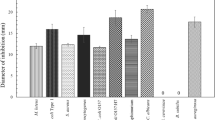Abstract
Streptococcus pneumoniae is an important human bacterial pathogen, and the increase in antibiotic resistance demands the development of new antimicrobial compounds. Several reports have suggested that yeast killer toxins show activity against bacteria and we therefore investigated the activity of K9 killer toxin from the yeast Williopsis saturnus var. mrakii NCYC 500 against S. pneumoniae. However, no inhibition of bacterial growth was observed with concentrated K9 preparations in agar diffusion assays and in liquid culture. Although cell morphology was slightly affected by K9 treatment, no effect on cellular viability was detectable, and K9 had no stimulatory effect on cell lysis induced by β-lactams or Triton X-100. This indicated that K9 did not contribute to cell wall damage. Moreover, flow cytometry was used as a sensitive assessment of integrity of cells exposed to killer toxin. No significant damage of S. pneumoniae cells was evident, although minor changes in fluorescence suggested that K9 killer toxin may interact with bacterial surface components.





Similar content being viewed by others
References
Alloing G, Granadel C, Morrison DA, Claverys J-P (1996) Competence pheromone, oligopeptide permease, and induction of competence in Streptococcus pneumoniae. Mol Microbiol 21:471–478
Avery OT, MacLeod CM, McCarty M (1944) Studies on the chemical nature of the substance inducing transformation of pneumococcal types induction of transformation by a deoxyribonucleic acid fraction isolated from pneumococcus type III. J Exp Med 79:137–158
Bevan EA, Makover M (1963) The physiological basis of the killer character in yeast. Proc 11th Int Cong Genetics 1:202–203
Boye E, Steen HB, Skarstad K (1983) Flow cytometry of bacteria: a promising tool in experimental and clinical microbiology. J Gen Microbiol 129:973–980
Bricker AL, Camilli A (1999) Transformation of a type 4 encapsulated strain of Streptococcus pneumoniae. FEMS Microbiol Lett 172:131–135
Brussow H, Desiere F (2001) Comparative phage genomics and the evolution of Siphoviridae: insights from dairy phages. Mol Microbiol 39:213–222
Buzzini P, Martini A (2000) Differential growth inhibition as a tool to increase the discriminating power of killer toxin sensitivity in fingerprinting of yeasts. FEMS Microbiol Lett 193:31–36
Buzzini P, Corazzi L, Turchetti B, Buratta M, Martini A (2004) Characterization of the in vitro antimycotic activity of a novel killer protein from Williopsis saturnus DBVPG 4561 against emerging pathogenic yeasts. FEMS Microbiol Lett 238:359–365
Cohn M, Horibata K (1959) Analysis of the differentiation and of the heterogeneity within a population of Escherichia coli undergoing induced β-galactosidase synthesis. J Bacteriol 78:613–623
Conti S, Magliani W, Arseni S, Dieci E, Frazzi R, Salati A, Varaldo PE, Polonelli L (2000) In vitro activity of monoclonal and recombinant yeast killer toxin-like antibodies against antibiotic-resistant gram-positive cocci. Mol Med 6:613–619
Conti S, Magliani W, Arseni S, Frazzi R, Salati A, Ravanetti L, Polonelli L (2002) Inhibition by yeast killer toxin-like antibodies of oral Streptococci adhesion to tooth surfaces in an ex vivo model. Mol Med 8:313–317
Creanor J, Toyne J (1993) Preparations of synchronous cultures of the yeasts Saccharomyces cerevisiae and Schizosaccharomyces pombe. In: Fantes P, Books R (eds) The cell cycle practical approach. IRL Press, Oxford, p 254
Green L, Petersen B, Steimel L, Haeber P, Current W (1994) Rapid determination of antifungal activity by flow cytometry. J Clin Microbiol 32:1088–1091
Guyard C, Seguy N, Cailliez JC, Drobecq H, Polonelli L, Dei-Cas E, Mercenier A, Menozzi FD (2002) Characterization of a Williopsis saturnus var. mrakii high molecular weight secreted killer toxin with broad-spectrum antimicrobial activity. J Antimicrob Chemother 49:961–971
Henriques-Normark B (2007) Molecular epidemiology and mechanisms for antibiotic resistance in Streptococcus pneumoniae. In: Hakenbeck R, Chhatwal GS (eds) Molecular biology of streptococci. Horizon Press, Wymondham, Norfolk, UK, pp 269–290
Hodgson VJ, Button D, Walker GM (1995) Anti-Candida activity of a novel killer toxin from the yeast Williopsis mrakii. Microbiology 141(Pt 8):2003–2012
Izgü F, Altinbay D (1997) Killer toxins of certain yeast strains have potential growth inhibitory activity on gram-positive pathogenic bacteria. Microbios 89:15–22
Lacks S, Hotchkiss RD (1960) A study of the genetic material determining an enzyme activity in pneumococcus. Biochem Biophys Acta 39:508–517
Palpacelli V, Ciani M, Rosini G (1991) Activity of different ‘killer’ yeasts on strains of yeast species undesirable in the food industry. FEMS Microbiol Lett 68:75–78
Polonelli L, Morace G (1986) Reevaluation of the yeast killer phenomenon. J Clin Microbiol 24:866–869
Schmitt MJ, Breinig F (2002) The viral killer system in yeast: from molecular biology to application. FEMS Microbiol Rev 26:257–276
Vadasz AS, Jagganath DB, Pretorius IS, Gupthar AS (2000) Electron microscopy of the K2 killer effect of Saccharomyces cerevisiae T 206 on a mesophilic wine yeast. Antonie Van Leeuwenhoek 78:117–122
Walker GM, McLeod AH, Hodgson VJ (1995) Interactions between killer yeasts and pathogenic fungi. FEMS Microbiol Lett 127:213–222
Yamamoto T, Uchida K, Hiratani T, Miyazaki T, Yagiu J, Yamaguchi H (1988) In vitro activity of the killer toxin from yeast Hansenula mrakii against yeasts and molds. J Antibiot (Tokyo) 41:398–403
Acknowledgments
The author thank Mr. J. Bennett for technical assistance and helpful suggestions during flow cytometry. This work was supported by a Georg-Foster grant from the Alexander von Humboldt Foundation to I. O.
Author information
Authors and Affiliations
Corresponding author
Rights and permissions
About this article
Cite this article
Ochigava, I., Collier, P.J., Walker, G.M. et al. Williopsis saturnus yeast killer toxin does not kill Streptococcus pneumoniae. Antonie van Leeuwenhoek 99, 559–566 (2011). https://doi.org/10.1007/s10482-010-9524-3
Received:
Accepted:
Published:
Issue Date:
DOI: https://doi.org/10.1007/s10482-010-9524-3




